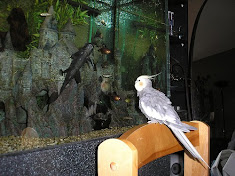 |
| Doggie Dental Care by Patricia H. Schuette |
•The upper back teeth are generally the worst areas, where the dog has periodontal disease. Plaque builds up on the surface of the teeth on a daily basis, especially under the gum line. It takes less than 36 hours for this plaque to mineralize and harden into tartar which cannot be removed by a brush. Therefore, your dog's teeth should be brushed on a daily basis in order to remove the plaque from under the gum line.
•Selecting a particular time of the day for tooth brushing that will become part of your dog's routine is extremely important. Your pet can in fact look forward to having his teeth brushed if it is before a walk or a daily treat. It will take a couple of days for both of you to become used to a teeth brushing session, which is why each session should be followed with praise and a walk, or a treat.
•Allow your dog to have a taste of the toothpaste before you begin. The next time allow him to taste the toothbrush, then run your finger along the gums of the upper teeth. This can then be followed by using the toothbrush. Allow the bristles of the toothbrush to run along the gum line of the upper back teeth and angle slightly up to enable the bristles to get under the gum line. Working from back to front, brushing in small circles along the gum lines is the best way to achieve clean teeth. No more than 30 seconds should be spent on brushing your dog's teeth. On your very first attempt at brushing your dogs teeth, do not attempt to brush them all. If your dog allows you to only brush the outside of the upper teeth, you will have achieved something. As he progresses with tooth brushing, he will permit you to brush more.
•Some dogs may require professional brushing. Just as we need to visit the dentist on a regular basis for check-ups, your dog may need to seek professional brushing.
Therefore, in order to ensure that your dog has healthier teeth with a sweeter smile, it is important to undertake daily brushing.
About the Author
Article by Kelly Marshall of Oh My Dog Supplies, check out our elevated dog feeders selection online.
Source: www.isnare.com
Permanent Link: http://www.isnare.com/?aid=489894&ca=Pets



0 comments:
Post a Comment